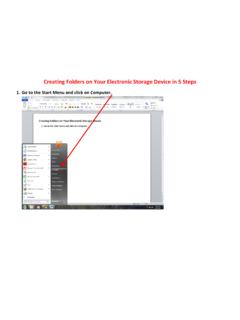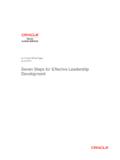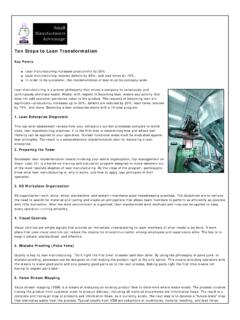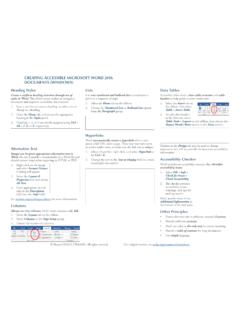Transcription of Simply Put - Centers for Disease Control and Prevention
1 Simply Put A guide for creating easy-to-understand materials What's in this guide? Communication that is Clear and Understandable ..3. Where this Guide Fits into an Overall Communication Plan ..4. Make Your Message Clear ..5. Text Appearance Matters ..9. Visuals Help Tell Your Story ..10. Layout and Design ..17. Consider Culture ..23. Translations Take Your Message Further ..25. Testing for Readability ..27. Appendix A - Checklist for Easy-to-Understand Print Appendix B - Resources for Communication Planning ..30. Appendix C - Formulas for Calculating Readability ..31. Appendix D - Resources ..38. Acknowledgements .43. Strategic and Proactive Communication Branch Division of Communication Services Office of the Associate Director for Communication Centers for Disease Control and Prevention Atlanta, Georgia April 2009.
2 Third Edition 2. Communication that is Clear and Understandable Communicating a broad range of health messages to a wide variety of audiences can be challenging. Differences among audiences make it necessary to avoid the one-size fits-all mindset when developing effective health communication materials. Culture and literacy skills are two important factors, among others, to consider when designing health communication materials that will capture the intended audience's attention. According to the National Assessment of Adult Literacy (NAAL), released in 2006 by the Department of One-third of Education, 30 million adults struggle with basic reading adults have tasks. The NAAL also found that only 12 percent of trouble reading consumers have proficient health literacy skills1 . suggesting that nearly nine out of ten adults may lack and acting on many of the skills necessary to sufficiently manage their health related health.
3 Low health literacy can affect a person's ability to information locate health care providers and services, fill out health forms, share personal health information with providers, Source: National center for Education Statistics, manage chronic diseases and engage in self-care. 2003 National Assessment of Adult Literacy It is important to remember; however, that even those with higher health literacy skills want health information that is understandable, meaningful to them, and easy to use. In This Guide: The guidance in Simply Put helps you transform complicated scientific and technical information into communication materials your audiences can relate to and understand. The guide provides practical ways to organize information and use language and visuals. This guide will be useful for creating fact sheets, FAQ's, brochures, booklets, pamphlets, and other materials, including web content.
4 3. Where this Guide Fits into an Overall Communication Plan Developing a communication plan involves many steps. This guide will help you accomplish just one of them designing your health communication materials. There are several things to do before you start: Steps for Developing Health Communication Materials Identify the intended audience and define the key health That Are Evidence-Based and User problem/s or interest/s. Friendly Get to know the intended audience to help determine 1. Identify intended audience and their key characteristics, including gender, race/ethnicity, define/research the key health location, beliefs, behaviors, culture, literacy skills, and problems or interests current knowledge about the identified topic. 2. Engage the intended audience- determine what their needs, Determine key messages.
5 Be sure to test them with the beliefs/values, and interests are, intended audience to ensure they will be received and their level of knowledge of the appropriately. identified health topic Determine the best way to communicate messages to the 3. Determine key concepts and audience ( , print, audio, video). messages based on knowledge of the audience Decide how to distribute the materials to the audience 4. Design a draft of the material ( , mail, brochure display, web page). 5. Pretest materials with intended audience 6. Tweak draft according to feedback An early step in the development process is determining from the audience whether the intended audience needs or wants the information 7. Publish and distribute materials your material will provide. This ensures that funds and staff 8. Evaluate the audiences' satisfaction time will be used wisely.
6 Learning about the interests, needs, and understanding and values of the intended audience allows for more targeted materials. Knowing the best ways to reach your audience will help to decide on the most effective format and design for your materials. Once you have developed a draft of your material, be sure to pretest it with the intended audience. Pretesting helps ensure that the message you send is the message your intended audience receives, rather than some other interpretation. Make appropriate revisions to your materials according to the findings of the pretest. The final steps in developing health communication materials are to market it and distribute it, and re- evaluate its effectiveness in communicating key messages to your intended audience. This guide does not discuss all of these steps, but Appendix B contains a list of resources to help you through many aspects of communication planning.
7 4. Make your Message Clear Creating materials that lead to increased knowledge or a change in beliefs, attitudes, or behaviors requires messages that are clear, relevant, and appropriate for the intended audience. This section gives tips for deciding what to say and how to say it so the audience will understand, remember, and act on your message. 1. Give the most important information first To quickly engage the audience: Give the most important information first Tell them what actions to take Explain why it is important to them For example: Always wash hands with soap and warm water for 20 seconds before and after handling food. Food and water can carry germs that may make you and your family sick. 2. Limit the number of messages Give your audience no more than three or four main ideas per document or section of your document.
8 Focus on what your audience needs to know and do. Skip details that are only nice to know. If you are writing a brochure on how to prevent Lyme Disease , you don't need to tell the audience how and when Lyme Disease was discovered. Tell them what to do to prevent it instead. Stick to one idea at a Stick to one idea at a time. Develop one idea fully before moving to the next idea. People are confused when materials skip back and time forth between topics. Avoid lengthy lists. Create short lists (3-7 items) with bullets, not commas. People with limited reading skills tend to forget items in longer lists. If you have a long list, break it into subheads. 3. Tell audiences what they need to do. Clearly state the actions you want your audience to take. Use concrete nouns and an active voice. Active voice is where the subject does the action.
9 Say: Follow these rules to avoid getting sick from food: Cook meat until it is not pink in the middle. Wash your hands after touching raw meat. 5. Wash fresh fruits and vegetables before eating them. Keep hot food hot and cold food cold. Not: Following safety precautions can reduce food-borne Disease transmission. Highlight the positive. Tell your audience what they should do rather than what they should not do. Use: Wear your helmet every time you ride your bicycle. Instead of: Do not ride your bicycle without wearing a helmet. 4. Tell your audience what they will gain from understanding and using the material . Tell your audience how your materials will benefit them. Answer the question, What's in it for me? . For example: You will learn what to do to have a healthy pregnancy and ways to prevent possible complications.
10 5. Choose your words carefully. Keep it short. Use words with one or two syllables when you can. Keep most sentences, if possible, between eight to ten words and limit paragraphs to three to five sentences. Communicate as if you were talking to a friend. A. conversational style has a more natural tone and is easy to Write as if you understand. were talking to a friend Say: You could get sick if you are near the chemical. Not: Exposure to the chemical could cause adverse health effects. Respect and value your audience. Don't talk down or preach. People are less likely to act on information if they are made to feel bad about their current behavior or health situation. Use a tone that encourages the audience. Emphasize small, practical steps. Offer concrete examples of successful action steps. 6.

















